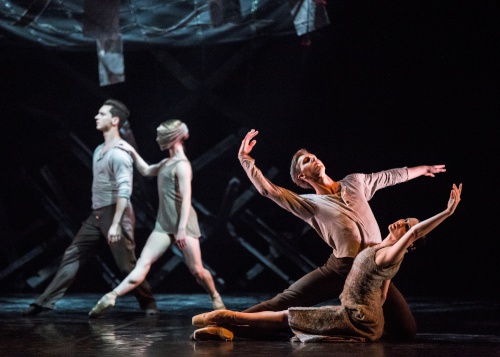Review: “Salute” by Royal New Zealand Ballet in Wellington
Review: “Salute” by Royal New Zealand Ballet in Wellington
By Megan Gattey

The Royal New Zealand Ballet performed “Salute” for a final time in Wellington on Sunday night, and it was nothing short of spectacular.
“Salute” marks the centenary of World War I by portraying the themes of comradeship, courage, and torment from a New Zealand perspective.
There are no main characters, with the entire cast enjoying seemingly equal time in the limelight.
The production is packed with a collection of four ballet works, including two world premieres, all in under three hours. The music is specially arranged by the New Zealand Army Band.
The skill of the cast rendered the show entirely captivating, with small stories running through every astounding movement and attenuated extension.
Each work is full of conceptual content, with chilling portrayals of love, loss, fear, and hope in war.

“Dear Horizon”, the first work in the show, began with two atmospheric spotlights on the conductor of the New Zealand Army Band.
Choreographer Andrew Simmons said “Dear Horizon” was not specific to any one war, so he chose to focus on universal human emotions of war.
Much was left to the audience’s imagination, allowing for varying and personal interpretations.
“It is my wish that the audience discover their own stories and additional themes,” Simmons said.
The score was specially commissioned by Gareth Farr, and was written for the New Zealand Army Band and cellist Rolf Gjelsten of the New Zealand String Quartet.
Gjelsten was welcomed onto the stage from the right wings to greet the audience afterwards.
Jirí Kylián from Czechoslovakia choreographed the second work, “Soldier’s Mass”.
It was originally created for Nederlands Dans Theatre in 1980, and has since been hailed as one of the landmark dance pieces of the 20th century.
The dance was created for 12 male dancers, of which the audience saw 11 on Sunday night. The twelfth dancer was a female.
The simplicity of the set, a red and black background, took nothing away from the dancers.
Shaun James Kelly danced with an impressive quality of dramatic expression, capturing the bittersweet lament of wartime.
The work ended with all twelve dancers removing their shirts and turning to face the audience in a chilling climax. The cadets were preparing for battle, and the dancers portrayed this sombre moment magnificently.
The third work, “Salute“, was created by Johan Jobborg in 2010.
It was the only section to bring comedy in the ballet.
“It’s basically about soldiers and their girlfriends. In Denmark we don’t have a…what do you call it? A prom. But that’s what I imagine it’s like,” Jobborg said.
There were humorous storylines in a selection of pas de deux, pas de trois, and even a pas de quatre; chiefly gibing at romantic jealousy and general unluckiness in love.
Katherine Grange stood out in this work, with a technically assured performance.
The music is a selection of short pieces by ‘the Strauss of the North’, the Danish composer Hans Christian Lumbye (1810-74).
The last work, "Passchendaele", was much more contemporary in nature than the previous three; evident in the contemporary-style of dance and the costumes.
Often ballet suffers from an inability to look beyond its own conventions. This is not true of choreographer Neil Ieremia’s “Passchendaele.”
The fierce music was inspired by a score composed by former Army Band member Warrant Officer Dwayne Bloomfield.
The rumbling trumpets and booming drums were powerfully immersive, and together with the dramatically dark colour scheme, they evoked acidic sorrow and melancholy.
The dancers in this work exuded the largeness of spirit and physical power necessary in a performance when representing New Zealand’s lost countrymen and women.
Much of the rich emotion the audience felt at the end was thanks to the endlessly engaging performances. The dance rose regally, and solemnly transported the audience back to Passchendaele.
“Passchendaele” proved to be a powerful ending to the show with surround-sound whistles and door-knocks heard all around the auditorium, fast drumrolls from the New Zealand Army Band, and panicked yet austere dancing.
The RNZB will now continue on a nationwide tour to six venues around New Zealand.
Tour dates:
Wellington St James Theatre: May 22-24
Christchurch Isaac Theatre Royal: May 28-30
Dunedin Regent Theatre: June 3
Hamilton Founders Theatre: June 10
Takapuna Bruce Mason Centre: June 13-14
Auckland ASB Theatre: June 17-20
Napier Municipal Theatre: June 24-25
Tickets are available
online at http://premier.ticketek.co.nz/, and by
calling 0800 TICKETEK.
ENDS


 Richard S. Ehrlich: Breaking Bad - China's DeepSeek A.I. Reveals Taboos
Richard S. Ehrlich: Breaking Bad - China's DeepSeek A.I. Reveals Taboos Martin LeFevre - Meditations: Blown Away In My Backyard
Martin LeFevre - Meditations: Blown Away In My Backyard Binoy Kampmark: Gloominess And Magical Thinking - The Comical, Frightening Mike Burgess
Binoy Kampmark: Gloominess And Magical Thinking - The Comical, Frightening Mike Burgess Gordon Campbell: On The Fall And Rise Of Pat Garrett And Billy The Kid
Gordon Campbell: On The Fall And Rise Of Pat Garrett And Billy The Kid  Martin LeFevre - Meditations: Is This A 1989 Moment?
Martin LeFevre - Meditations: Is This A 1989 Moment? Eugene Doyle: Human Sacrifice - Remembering Aaron Bushnell
Eugene Doyle: Human Sacrifice - Remembering Aaron Bushnell